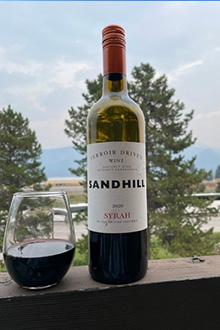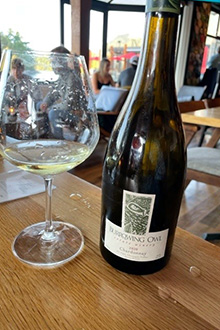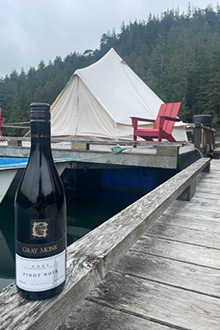Tasting Tour of Canadian Wine

Having just returned from holiday exploring the National Parks of British Columbia, Alberta and Vancouver Island, Canadian wine is firmly on my mind. Unfortunately, wild fires surrounding a lot of wine country in Okanagan put paid to the planned wine tours, but it didn’t stop me having the chance to try it pretty much every day.
The majority of production comes from Okanagan, in the West, and Niagara Peninsula, in the East. Most of the wine I tried was local to where I was staying, so pretty much all Okanagan in origin. That said, I did have to of course get an Ice Wine in which was from Niagara. For the most part, Canadian wine from Okanagan is largely influenced by the international varieties with excellent Chardonnay and Pinot Noirs, Syrah, Cabernet Franc, Riesling and so on. Hybrid varieties are also very important in Canada. These are crossings between two or more grape species. The most famous is Vidal, which is used predominantly for Icewine.
The climate in Canada is, as you might have guessed, extreme. If it isn’t blazing heat and fires to contend with then frost and heavy snow cover will likely be the problem. As a result, many of Canada’s vineyards are planted near the lakes which provide some moderating protection against these intense temperatures. Generally, Okanagan has a hot growing season coupled with cool nights meaning that the grapes achieve ripe flavours whilst maintaining high levels of acidity.

So, what was my impression? I was most eager to sample the Chardonnays and Pinot Noirs to see how these classic grapes fared in the climate. Overall, I was very impressed. The Chardonnays tended to be quite new world in style with plenty of winemaking influence. Usage of lees, oak and various other techniques all contributed to more buttery and fuller styles. A standout wine for me was the Burrowing Owl Chardonnay. As for the Pinot Noirs, these were all excellent too. One or two I tried had higher tannin than I was used to with Pinot, but this was actually quite a refreshing change and worked really well. These were mostly well toasted ones with lots of oak too. I strongly recommend Quails Gate, for both Chardonnay and Pinot.
Merlot was the next grape I felt I had to try, and it is actually the most planted variety in Okanagan. Again, due to the heat during the growing season the style of merlots was ripe, higher in tannin and alcohol and generally oaked. I had a particularly smoky one in an old bank turned bar in Calgary. One night a steak sharing platter called for Syrah. The Sandhill Syrah was a juicy, black fruit laden partner to this and it was fantastic. I also came across a Cabernet Franc from Black Sage vineyards, buying a bottle in the hope it would provide some lighter drinking whilst I was staying on a float camp off Vancouver Island. However, it was quite the opposite, which if I had read the label I might have guessed by the words ‘a bold choice’. Certainly, it is the heaviest style of Cabernet Franc I’ve ever had but that was no bad thing. It was juicy and dark and paired very well with yet more steak.
The grape which seemed to come up the most on menus amongst the whites was Pinot Gris. One I had was more Grigio in style with the fairly simple, fruity flavours that are so popular. But the majority were more Gris. Spiced, zippy and occasionally off-dry.
Continuing on the more Alsatian grapes, there was plenty of Riesling and Gewurztraminer available as well. One that really sticks out was a blend of the two by Jackson Triggs. It was off-dry and creamy, displaying vanilla and honeysuckle notes. This was nearly the most interesting thing I tried until I found a Sovereign Opal by Sandhill in one of the many state-run liquor stores. Sovereign Opal was intentionally developed in Canada, a crossing between Golden Muscat and Marechal Foch (which is related to Riesling). It was very light and easy drinking with tropical fruit notes from melon to grapefruit.
The dessert wines of Canada were equally good. Something I hadn’t expected was Burrowing Owl’s Coruja. It is a port-style wine made in a solera system, where young and old wines are blended constantly and the system never emptied. It was complex and, of course, tasty. Marzipan, cloves, vanilla, black pepper, blueberry, blackberry and plums to name a few all intermingled in a luscious wine.
It feels right to close this off with the Ice Wine since it is the nicest dessert wine I’ve tasted and more to the point, tends to cap things off. The Inniskillin Riseling icewine from Niagara Peninsula is something I’ll have to get my hands on again. The grapes are harvested at -10 degrees Celsius and pressed whilst still frozen. This means that the water in the grapes remains as ice in the press so that the sugar content in the juice that is squeezed out is very high. This does also mean that the amount produced is much smaller, resulting in much smaller bottles too. In fact, my only dislike of the wine was the 200ml bottle it came in. As I’ve said, the wine was superior to dessert wines I’ve previously tried, even Chateau d'Yquem. It was alive with citrus fruit, candied orange, marmalade, pineapple and mango which isn’t particularly unique for dessert wine. However, where it differed was the intense freshness and form of the acidity. It simply made such a difference to the elegance and balance of the wine.
All in all, if there is one thing I have learned it is that the Canadian wine scene is hugely impressive, just not quite as far reaching as I would like as it is not always easy to find in the UK. The States have an easier time of it though, of course. So, next time you want something from the new world, perhaps skip California and give Canada a go. Steer clear of the repetitive Californian style and try something artisan, value for money and absolutely delicious.


 Shop Canadian Wine >
Shop Canadian Wine >